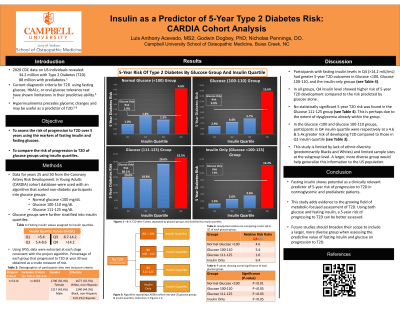Back

Clinical: General Topics
Insulin as a Predictor of 5-Year Type 2 Diabetes Risk: CARDIA Cohort Analysis
Friday, March 31, 2023
12:00 PM East Coast USA Time

- LA
Luis Acevedo, DO (he/him/his)
Medical Student
Campbell University School of Osteopathic Medicine
Angier, North Carolina, United States
Presenting Author(s)
Background and Hypothesis: Type 2 Diabetes (T2D) and prediabetes impact a large portion of people living in the United States. Insulin resistance and hyperinsulinemia underlie the pathogenesis of this disease. Patients often present with negative health effects before a diagnosis of T2D is made, which leads us to ask if our current risk prediction measures are adequate. Fasting insulin has been shown in studies to be an independent predictor of development of T2D and often precedes the glycemic measures we use to diagnose prediabetes and T2D currently. We hypothesize there is a relationship between fasting insulin and progression to T2D that can be used to improve the predictive ability of current methods for assessing T2D risk. We will do this by assessing the risk of progression to T2D over 5 years using the markers of fasting insulin and fasting glucose and comparing the risk of progression to T2D of glucose groups using insulin quartiles.
Methods: The Coronary Artery Risk Development in Young Adults (CARDIA) study represents a large cohort of people who have been receiving regular follow-up to collect important biological markers since 1985. Using this retrospective cohort analysis, we analyzed the 5-year risk prediction of fasting insulin alone and in combination with fasting glucose. Data for years 25 and 30 from the CARDIA cohort database were used with an algorithm that sorted non-diabetic participants into glucose groups and further stratified into insulin quartiles. Using SPSS, data were extracted at each stage consistent with the project algorithm. Percentage of each group that progressed to T2D at year 30 was obtained as a crude measure of risk.
Results: “Glucose < 100 mg/dL” group reported an overall risk of 1.9%. When stratified by insulin quartiles, Q1, Q2, Q3, Q4 showed a 5 year risk of 1.0%, 1.8%, 1.5%, and 4.6%, respectively (p < 0.01).
“Glucose 100 - 110 mg/dL” group reported an overall risk of 9.0%. When stratified by insulin quartiles, Q1, Q2, Q3, Q4 showed a 5 year risk of 2.9%, 4.4%, 5.7%, and 15.6%, respectively (p < 0.05).
“Glucose 111 - 125 mg/dL” group reported an overall risk of 30.1%. When stratified by insulin quartiles, Q1, Q2, Q3, Q4 showed a 5 year risk of 20.0%, 18.8%, 28.6%, and 32.5%, respectively (p>0.05).
The “Insulin only” groups were also analyzed for 5 year risk of T2D. Q1, Q2, Q3, Q4 showed a 5 year risk of 1.3%, 2.6%, 3.6%, and 12.2%, respectively (p < 0.05).
Conclusion: Fasting insulin shows potential as a clinically relevant predictor of 5-year risk of progression to T2D in normoglycemic and prediabetic patients. Clinicians can benefit from using fasting insulin in combination with fasting glucose to identify individuals at high risk so interventions like diet and lifestyle can be implemented early on. This study adds evidence to the growing field of metabolic-focused assessment of T2D and shows fasting insulin can be a clinically relevant predictor of T2D.
Acknowledgement of Research Study Sponsors and IRB: IRB approved exemption status for the proposal "Evaluation of fasting insulin, insulin resistance, and weight change by glycemic stage in the CARDIA study" from which this study was derived.
Methods: The Coronary Artery Risk Development in Young Adults (CARDIA) study represents a large cohort of people who have been receiving regular follow-up to collect important biological markers since 1985. Using this retrospective cohort analysis, we analyzed the 5-year risk prediction of fasting insulin alone and in combination with fasting glucose. Data for years 25 and 30 from the CARDIA cohort database were used with an algorithm that sorted non-diabetic participants into glucose groups and further stratified into insulin quartiles. Using SPSS, data were extracted at each stage consistent with the project algorithm. Percentage of each group that progressed to T2D at year 30 was obtained as a crude measure of risk.
Results: “Glucose < 100 mg/dL” group reported an overall risk of 1.9%. When stratified by insulin quartiles, Q1, Q2, Q3, Q4 showed a 5 year risk of 1.0%, 1.8%, 1.5%, and 4.6%, respectively (p < 0.01).
“Glucose 100 - 110 mg/dL” group reported an overall risk of 9.0%. When stratified by insulin quartiles, Q1, Q2, Q3, Q4 showed a 5 year risk of 2.9%, 4.4%, 5.7%, and 15.6%, respectively (p < 0.05).
“Glucose 111 - 125 mg/dL” group reported an overall risk of 30.1%. When stratified by insulin quartiles, Q1, Q2, Q3, Q4 showed a 5 year risk of 20.0%, 18.8%, 28.6%, and 32.5%, respectively (p>0.05).
The “Insulin only” groups were also analyzed for 5 year risk of T2D. Q1, Q2, Q3, Q4 showed a 5 year risk of 1.3%, 2.6%, 3.6%, and 12.2%, respectively (p < 0.05).
Conclusion: Fasting insulin shows potential as a clinically relevant predictor of 5-year risk of progression to T2D in normoglycemic and prediabetic patients. Clinicians can benefit from using fasting insulin in combination with fasting glucose to identify individuals at high risk so interventions like diet and lifestyle can be implemented early on. This study adds evidence to the growing field of metabolic-focused assessment of T2D and shows fasting insulin can be a clinically relevant predictor of T2D.
Acknowledgement of Research Study Sponsors and IRB: IRB approved exemption status for the proposal "Evaluation of fasting insulin, insulin resistance, and weight change by glycemic stage in the CARDIA study" from which this study was derived.
